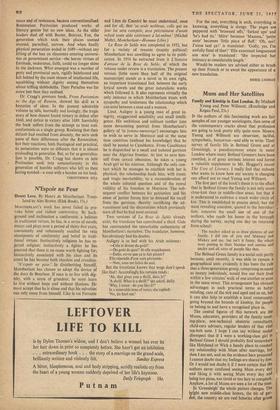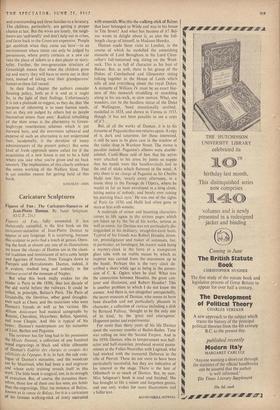Mum and Her Satellites
IF the authors of this fascinating work are fair samples of our younger sociologists, then some of the contemporary cracks about that profession are going to look pretty silly quite soon. Messrs Young and Willmott are observant, tactful, sympathetic, humorous—and able to write. Their survey of family life in Bethnal Green and at Greenleigh, a pseudonymous estate in outer London where many Bethnal Greeners have been resettled, is of great intrinsic interest and forms a valuable supplement to Mr. Hoggart's recent The Uses of Literacy. I really feel that nobody who wants to know how our society is changing can afford not td read Young and Willmott.
The first part of the book's thesis is to the effect that in Bethnal Green the family is not only more close-knit than in middle-class areas, but that it is understood to embrace a much wider circle of kin. This is established in precise detail, but the most revealing anecdote, quoted in the Introduc- tion, concerns the small son of one of the authors, who made his home in the borough during the survey, saying one day on returning from school : The teacher asked us to draw pictures of out family. I did one of you and Mummy and Mickey and me, but isn't it funny, the others were putting in their Nannas and aunties and uncles and all sorts of people like that.
The Bethnal Green family is a social unit partly because, until recently, it was able to remain a geographical unit; evidently it has been the rule that a three-generation group, comprising as many as twenty individuals, would live out their lives within a few minutes' walk of one another or even in the same street. This arrangement has obvious advantages in such practical terms as baby minding, care of the sick and aged and so on, but it can also help to establish a local community, going beyond the bounds of kinship, for people to belong to and have a recognised place in.
The central figures of this network are the Mums, educators, providers of the family meet' ing-place, non-technical obstetric consultants, child-care advisers, regular lenders of that vital ten-bob note. I hope I can say without undue disrespect that if I were a working-class girl io Bethnal Green I should probably find somewhere like Holyhead or Wick a handy place to conduct my relationship with Mum after marriage, but then I am not, and on the evidence here presented I cannot doubt that my feelings are shared by few. Or I would not doubt it if I were certain that the authors never confused seeing Mum every day and liking it with seeing Mum every day and being too pious, too timid or too lazy to complain. Anyhow, a lot of Mums are seen a lot of the time.
In `Greenleigh' the whole picture changes. The 'Night new middle-class homes, the bit of gar' den, the country air are real luxuries after grime and overcrowding and three families to a lavatory. The children, particularly, are getting a proper chance at last. But the wives are lonely, the neigh- bours are 'unfriendly' and don't help out in crises, and fares back to the Green are expensive. `People get snobbish when they come out here'—to an environment where status can only be judged by possessions, where pretty curtains or a new car take the place of talents as a dart-player or story- teller. Further, the two-generation structure of Greenleigh means that when the children grow up and marry they will have to move out in their turn, instead of taking over their grandparents' houses as these fall vacant.
In their final chapter the authors consider housing policy, both as it is and as it might be, in the light of their findings. Unfortunately it is not a platitude to suggest, as they do, that 'the purpose of rehousing is to meet human needs, not as they are judged by others but as people themselves assess their own.' Radical rebuilding of the slum areas is the alternative to Green- leigh-type resettlement schemes which is put forward here, and the enormous upheaval and expense of such an alternative is not underrated (nor, incidentally, is the devotion of many administrators of the present policy). But some kind of fresh approach seems called for if the acquisition of a new house is not to be a field where you take what you're given and no back answers. The implications of this clearly embrace the entire working of the Welfare State. That is yet another reason for getting hold of this book.
K I NGSLEY AM1S



































 Previous page
Previous page